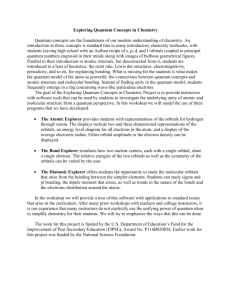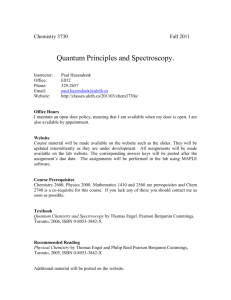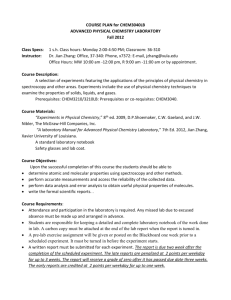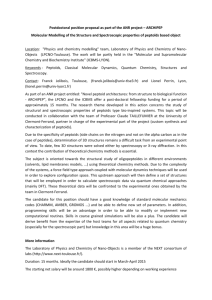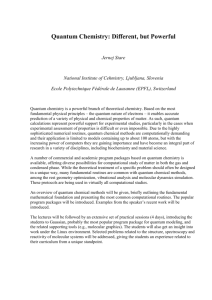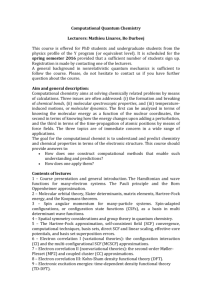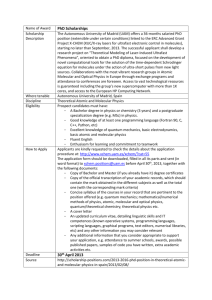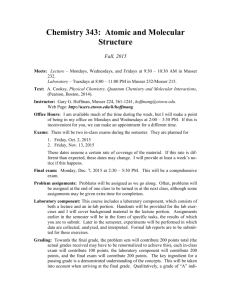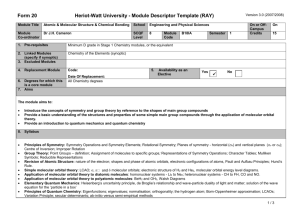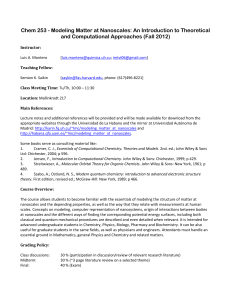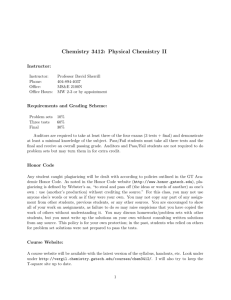Chemistry 218 Fall 2002-2003 Molecular Structure R. Sultan course
advertisement
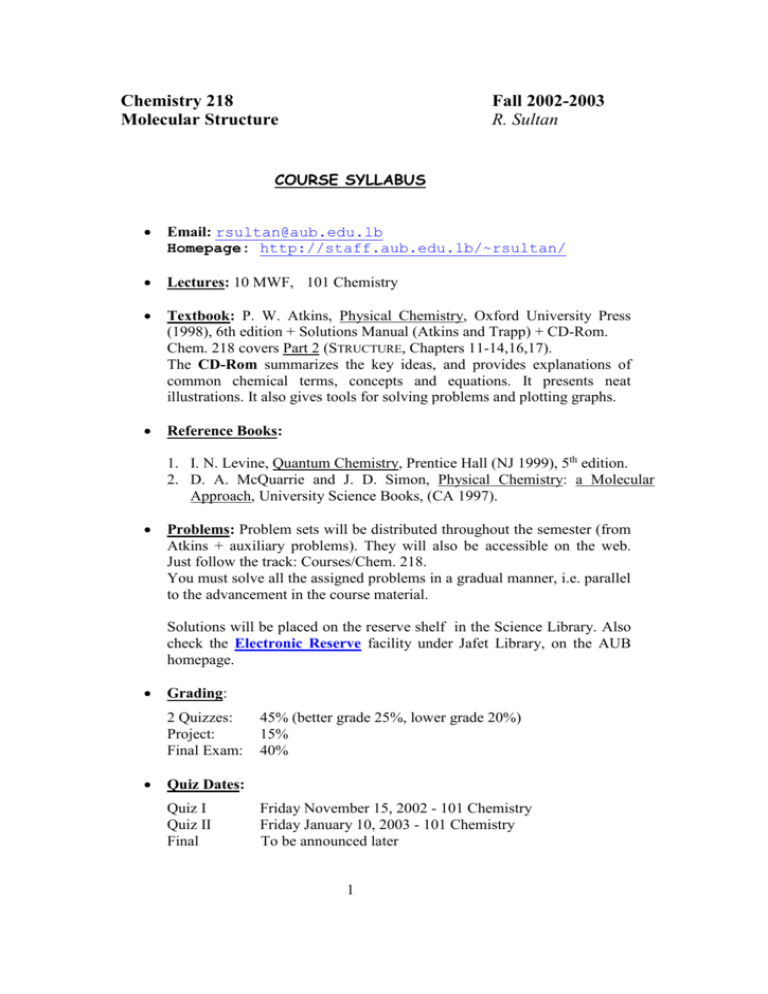
Chemistry 218 Molecular Structure Fall 2002-2003 R. Sultan COURSE SYLLABUS Email: rsultan@aub.edu.lb Homepage: http://staff.aub.edu.lb/~rsultan/ Lectures: 10 MWF, 101 Chemistry Textbook: P. W. Atkins, Physical Chemistry, Oxford University Press (1998), 6th edition + Solutions Manual (Atkins and Trapp) + CD-Rom. Chem. 218 covers Part 2 (STRUCTURE, Chapters 11-14,16,17). The CD-Rom summarizes the key ideas, and provides explanations of common chemical terms, concepts and equations. It presents neat illustrations. It also gives tools for solving problems and plotting graphs. Reference Books: 1. I. N. Levine, Quantum Chemistry, Prentice Hall (NJ 1999), 5th edition. 2. D. A. McQuarrie and J. D. Simon, Physical Chemistry: a Molecular Approach, University Science Books, (CA 1997). Problems: Problem sets will be distributed throughout the semester (from Atkins + auxiliary problems). They will also be accessible on the web. Just follow the track: Courses/Chem. 218. You must solve all the assigned problems in a gradual manner, i.e. parallel to the advancement in the course material. Solutions will be placed on the reserve shelf in the Science Library. Also check the Electronic Reserve facility under Jafet Library, on the AUB homepage. Grading: 2 Quizzes: Project: Final Exam: 45% (better grade 25%, lower grade 20%) 15% 40% Quiz Dates: Quiz I Quiz II Final Friday November 15, 2002 - 101 Chemistry Friday January 10, 2003 - 101 Chemistry To be announced later 1 COURSE CONTENTS Subject Section in Atkins CENTRAL IDEAS IN QUANTUM MECHANICS further information 4 QUANTUM THEORY Failures of classical mechanics Blackbody radiation - Heat capacities of solids - Atomic and molecular spectra Wave-particle duality Photoelectric effect - Electron diffraction - DeBroglie's relation 11.1 11.2 Dynamics of microscopic systems Schrödinger equation Postulates of Quantum Mechanics Operators and observables Superposition and expectation values Uncertainty principle 11.3,4 -11.5 11.5 11.6 QM models of particle motion Translational motion Free particle - Particle in-a-box Tunneling Vibrational motion Simple harmonic oscillator (SHO) Rotational motion Particle on-a-ring Quantization of angular momentum Rotation in three dimensions The vector model Spin 12.1 12.1,2 12.3 12.4,5 12.6 12.7 12.8 ATOMIC THEORY Spectrum of the Hydrogen atom Quantum mechanical interpretation Atomic orbitals Quantum mechanical calculations (H-atom) Spectral transitions - Selection rules 2 13.1 13.2 13.3 Helium atom - Pauli principle Orbital approximation Many-electron atoms - Aufbau principle SCF orbitals Spectra of complex atoms Quantum defects and ionization limits Triplet and singlet states Spin-orbit coupling Atomic term symbols - Spectral selection rules Effect of magnetic field - Zeeman effect 13.4 13.4 13.5 13.6 13.7 13.8 13.9 13.10 MOLECULAR STRUCTURE H 2 molecule-ion MO-LCAO treatment - Variation principle VB Theory – H 2 molecule Homonuclear diatomic molecules Classification of molecular orbitals Molecular term symbols Heteronuclear diatomics Hybridization MO’s for Polyatomic systems – Walsh diagrams Hückel M.O -electron theory 14.4 14.4,7 14.1 14.5 14.6 14.7 14.3 14.8 14.9 ROTATION AND VIBRATION SPECTRA Features of spectroscopy Moments of inertia Rotational energy levels Spherical top molecules Symmetric tops - Linear molecules Rotational transitions - selection rules Harmonic oscillator - vibrational energy levels Selection rules Morse potential - Anharmonicity Ro-vibrational spectra of diatomic molecules 16.2,3 16.4 16.5 16.6 16.9 16.10 16.11 16.12 ELECTRONIC SPECTRA Electronic excited states of molecules Spectral transitions Franck-Condon principle Fates of electronically excited states 3 17.1,2 17.3
